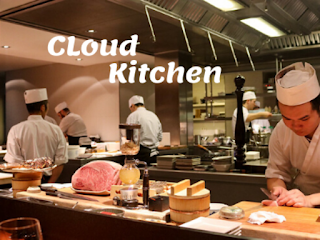CLOUD KITCHEN STARTUP IN INDIA
The Cloud kitchen business is very beneficial in the modern era. The two players in the online food delivery business are SWIGGY and ZOMATO. Cloud kitchens are facilities that have been centralized for producing commercial food. These are perfect examples of how technology can be used to manage an entire business. In recent years, the food services and restaurant industry have gained a more extensive consumer base, especially after the pandemic.

CONCEPT
Cloud kitchens are restaurants that only have kitchens. They are essentially food production facilities where dozens of restaurants rent space to prepare delivery-optimized food items. Cloud kitchens, and ghost kitchens, are basically delivery-only restaurant business models. They do not offer dining options and cater to their customers solely through online delivery. Their infrastructure basically includes a kitchen set-up tie with food-delivery applications. In recent times, cloud kitchens are revolutionizing the food and beverage industry with advanced technology, changing consumer food consumption trends, and an operationally sound model of automated deliveries, complex machine learning algorithms, and a skilled workforce will be critical factors in shaping the future of the food service industry in India. Google supports this concept and consumers can locate a variety of cloud kitchens in their locality when they browse the internet. Technology plays a crucial role as most orders are made online through a website, apps, and delivery aggregate.
ADVANTAGES
The cloud kitchen is eliminating costs such as restaurant space, decor, dining tables, chairs, high-end cutlery, and electrical fixtures. Its functions are on price effective business model with expenditure limited food ingredients, kitchen equipment, and minor maintenance costs such as energy bills. It utilizes a commercial kitchen to prepare food for delivery or takeout only, with no-dine-in customers to expand an existing restaurant or start a virtual brand at a minimal cost. This business model is flexible and can change the menu, and cuisines theme much easier than a dine-in restaurant. If a cloud kitchen finds some menu items not very profitable, the same can be swapped without reprinting the menu and avoiding extra cost. Since you don’t need a restaurant at a prime location or hire staff to serve customers, it takes only one-third of the time and resources to open a cloud kitchen as compared to a traditional dine-in restaurant.
DISADVANTAGES
Customers are not really ready to pay the same price as a restaurant without the ambience and experience to support it. And the customer who orders frequently from cloud kitchens is looking for deals-hardly the type of customer that can bring in sustainable, profitable revenue. Hence, they don’t have pricing power and need to keep prices low and run deals constantly to attract new customers. The commission rate of Swiggy and Zomoto is 18-40% which varies at different parameters. This is the biggest disadvantage of Swiggy and Zomoto. Due to the commission rate, you cannot offer a big discount to your customers. The main advantage of cloud kitchen is also one disadvantage. As these new-age kitchens are growing, it is noted that they are highly dependent on food aggregate apps. In case an aggregate app is banned or performs poorly or is affected by certain regulatory issues, then despite the best efforts, and performance of the dependent cloud kitchens decreases.

FUTURE OF CLOUD KITCHEN
Cloud Kitchen is not only the future but it has become the latest trend now. The cloud kitchen market is going to expand at a higher rate in the future with the surge in the demand for online food delivery services. According to Data Lab by Inc 42, the food ordering market in India is expanding at a Center For Advanced Computing Research (CACR) of 16% to reach $17 billion by 2023. The projected market size of cloud kitchens is expected to reach $1.05 billion by 2023. Technology including ground-based robots and aerial drones could further assist in reducing delivery costs. Also, automated standardized processes that use machine learning-based prediction tools and robot chefs to prepare customized quality meals in less time at lightning-fast delivery speed are set of redefining the future of the cloud kitchen industry. The proposal to boost cloud kitchen was first unveiled recently as part of the Kejriwal government’s employment-focused ‘Rojgar Budget’ 2022-23 which plans to create 20 lakh jobs in 5 years. “Cloud kitchens have a huge potential to attract investment, increase the market size of the Food and Beverage (F&B) sector and generate large-scale direct and indirect jobs. “We are committed to further facilitating the growth of this strongly emerging segment by encouraging the setting up of shared commercial kitchen spaces across Delhi,” Mr Jasmine Shah, Vice-chairperson, of Dialogue and Development (DDC) said.
In today’s purview, any innovation seeking to serve the sit-in lifestyle of the masses is an already set business for success. Consumerism and lifestyle changes are the main reasons for the success of cloud kitchens in India.


